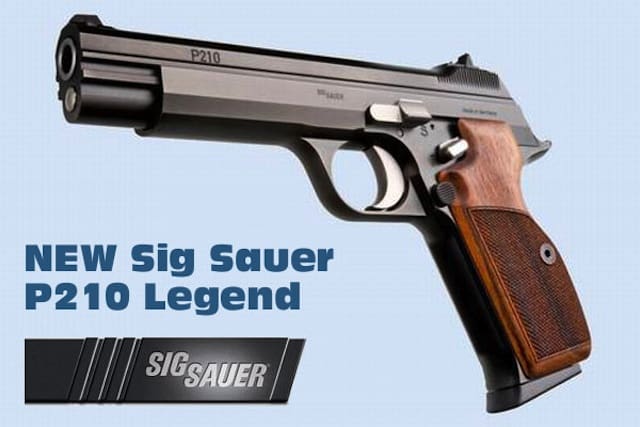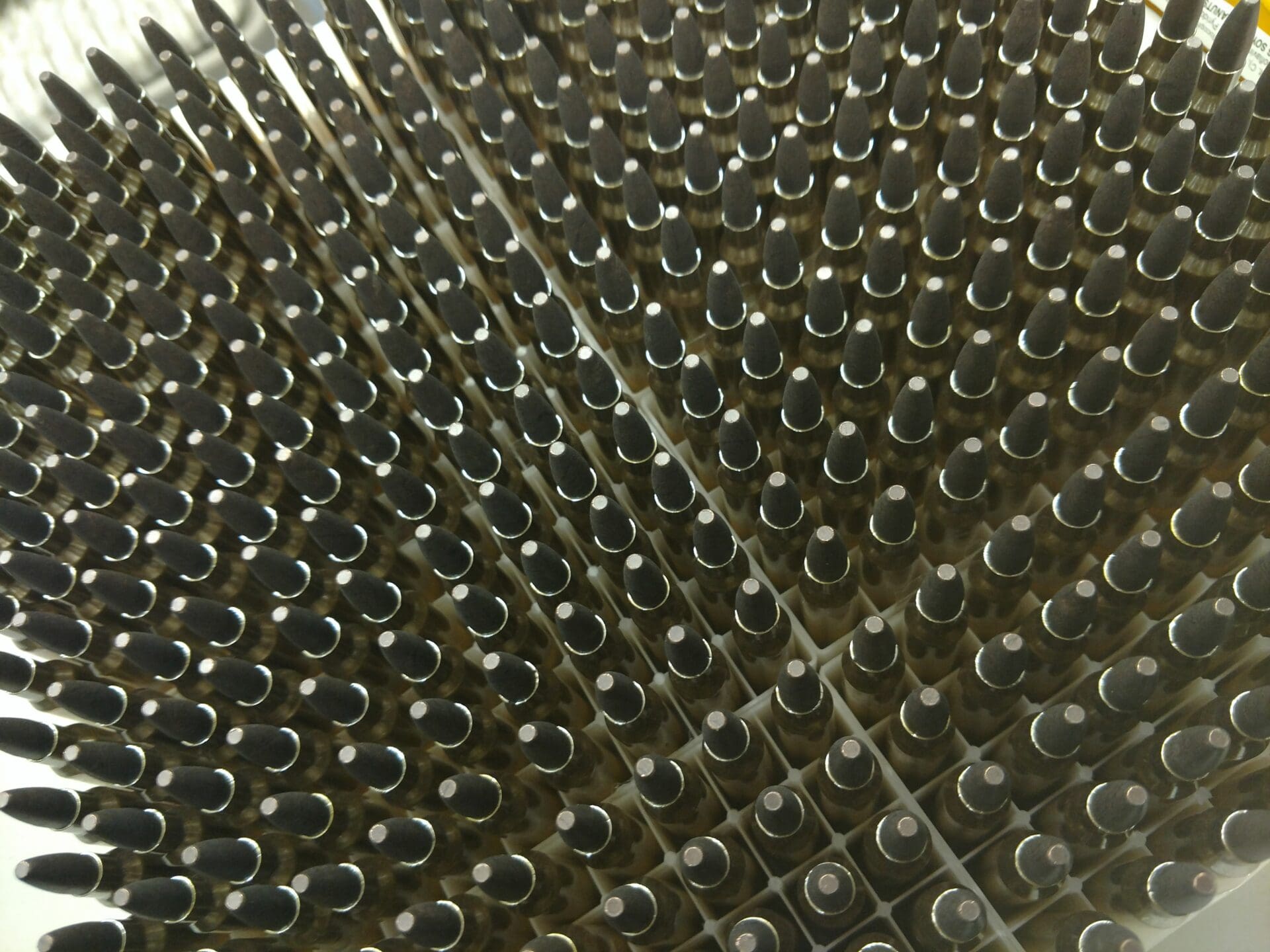Quick! Name a gun that’s less accurate than you are. Yes, that’s a trick question. But let’s face it: most modern handguns are far more accurate than their shooter’s ability to capitalize on the gun’s accuracy relative to another similar weapon. In other words, it’s all about operator skill rather than mechanical design. Shhhh. Don’t tell that to the manufacturers, who are more than happy to play up their weapon’s accuracy in search of street cred and sales. For example, the return of the SIG SAUER P210, now with added legendarynessosityhooditude Oh wait. It’s a target pistol. That’s different, right? (Make the jump for the 411 from gunsforsale.com.)
The [what’s old is] new 9mm, single-action P210 will come in two basic models, with one having drift adjustable post and notch sights. The other model will feature adjustable target sights (see photo). Both version of the new P210 will feature the Sig black Nitron [QPQ] finish, manual safety, and a “US-style” [thumb-activated] magazine release. The original P210 utilized a heel mag release.” The new rear target sight has a 3-position slider that adjusts for three different target distances.
According to Sig Sauer, this suits “static-precision disciplines or PPC 1500″, because the shooter can quickly re-zero the P210 for three different ranges. That’s a smart feature we’d like to see on other target pistols.





Do want.
Oh I’ve only ever man-handled a P210 once in the past, and I still want one!
I hope it’s not a new model. New model SIGs are as reliable as bad 1911s.
OMG Rabbi – you’re killing me! What now? I have 3 new SIG’s – what is wrong with them? The friend who lent me the Beretta for next week’s TTAG gun review also have 3 of them (all new) and his also run flawlessly.
*has
Many of Sigs NEW designs have been released before their time. Think Mosquito… SIG250….
They eventually get them running.
You make a good point. All of my handguns (Buckmark Camper, CW9, RIA 1911A1, even the P3At and Taurus 85 snubbie) are more accurate than my ability to shoot them accurately. They all do their intended jobs quite well, particularly when I cooperate and do what I’m supposed to do.
A Sig P210? More accurate than (almost) any of us, even on our good days. Ditto for any Browning Buckmark. Any handgun that can shoot a 4″ group at 50 yards (which I can sometimes do, with a scoped pistol, off of sandbags) deserves a better pistolero than me.
A Glock, Beretta, Kahr, XD? Probably a hair more accurate than I am, but perhaps a little more difficult to shoot with precision due to combat-oriented (as opposed to target-oriented) ergonomics and controls.
But a .38 snubnose, or a box-stock Norinco 1911? Emphatically *not* more accurate than I am. I can shoot a tighter group offhand with my Buckmark than Guns & Ammo can get from a Ransom-Rested Taurus Model 85.
This isn’t a boast; I don’t consider myself exceptional in this regard. With excellent ergonomics, no recoil, and a long fixed barrel, target pistols like the Buckmark (or Ruger Mark II Target model) will show you just how good a shot you can be. Most of us are pleasantly surprised.
I’m much more accurate with my Buckmark than with my 85, too. I would hope just about anyone would be. That’s going to happen with a light-triggered 6″ sight radius gun vs. one with a long-pulling, heavy-triggered, 3″ sight radius.
But again, it’s the shooter. Snubbies are close-in, inherently difficult-to-shoot guns. But the fact that I get 6-7 inch groups at 21 feet with it isn’t the gun’s fault. It’s mine. I’m pretty sure I’d get 2 inch groups with it in a vise.
I wonder what it’ll cost. I also wonder what it will do to the pricing of the “real p210’s”.
No gun can be more accurate than its shooter’s ability to capitalize on its accuracy relative to another similar weapon. As explained here, mechanical accuracy of your firearm is defined as its intrinsic capacity to deliver bullets to the point of aim, irrespectively of all human factors. It is characterized by the figure described in the target plane by bullets it throws downrange, with its frame rigidly fixed in a machine rest. Likewise, your physiological capacity to hold and aim the handgun is characterized by the figure described in the target plane by your actual point of aim found at the intersection of the sight line with the target plane, deviating from your intended point of aim. Let us assume that your handgun is sighted in for consistent ballistic performance of your ammunition at the range equal to your distance from the target. That is, under these circumstances, the statistically average point of impact will coincide with the point of aim. With a centerfire pistol fired at short ranges, wind drift is a negligible factor. Accordingly, once the bullet leaves the barrel of your handgun, its point of impact will have been determined. As the shooter, you are in control of this determination, to the extent of your accuracy of aim and consistency of trigger letoff and follow-through. We shall consider radial deviation of the bullet’s impact in the target plane, conventionally designated by the hour mark in a clock dial. Let us neglect the effect of gravity and the likelihood and aptness of your muscular compensation therefor. Thus we assume for the sake of simplifying our analysis, that you are equally likely to deviate from your intended point of aim radially in any given direction. To this extent, your physiological capacity to hold and aim the handgun becomes circumscribed by a circle projected into the target plane by its sight line. Likewise, we assume that the point of bullet impact in the target plane is equally likely to deviate from the actual point of aim radially in any given direction. To this extent, the mechanical accuracy of your handgun is circumscribed by another circle, defined by the parabolic trajectory of your bullets, as it intersects the target plane. In this way, the arc of the gun superimposes upon the arc of the shooter. In other words, the mechanical looseness built into your handgun in order to ensure its reliable operation, compounds your errors of aiming, shooting, and following through. It does so regardless of the ratio of looseness to error. This compounding of error occurs as the center of the circle defined by mechanical dispersion ranges inside the circle defined by your capacity to hold and aim.
Compounding of shooting errors becomes minimized in the hands of a good shot firing an accurate handgun. On the other hand, a shaky shooter given to habitual deviation from his target cannot reap much of a benefit from increased precision of his firearm. Generally speaking, the human factor counts for more than mechanical looseness in missing your target. For a careless shooter, shot dispersion stemming from his error tends to exceed its dispersion owed to the mechanical looseness of his gun. But aside from that, there is no sense in the notion of not needing a gun that shoots better than oneself. Even the beginner will visibly benefit from choosing a more accurate arm.
That said, I found the Sauer P210 Legend wanting in many ways, with respect to its Swiss prototype.
super info thank’x for tell us.